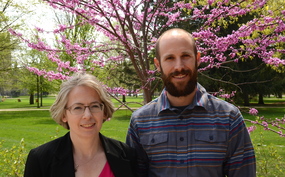Students learn. Teachers teach. It’s widely accepted as the natural order.
Except Kim Smith wasn’t about to let Carleton’s ambitious undergrads have all the fun.
Inspired by the Foreign Language Across the Curriculum model, which might link a Spanish language course with the history of Spain, Smith approached fellow professor Dan Hernandez about connecting environmental studies (her area of expertise) and natural science (his) over winter term. Hernandez would continue teaching Global Change Biology, a required course for environmental studies majors, while Smith would add a once-a-week co-requisite called Ethics and Ecology. The simultaneous classes would give students a chance to digest scientific concepts with Hernandez while exploring deeper ethical ramifications under Smith’s tutelage.
It also meant both professors spent a lot of time in each other’s classes, listening to lectures and devouring texts—basically becoming students again. The results were illuminating, even to two seasoned academic veterans.
“Sitting in on Dan’s course and going over the readings is already paying off. I have a much better understanding of what I’m doing in environmental ethics, and how it corresponds with other courses in the curriculum,” Smith says.
“Beyond our own professional development, we also knew it would be great for students. It was still the material that both of us really knew how to teach, just with the added time commitment of complementing each other’s texts. It was really combining something new with something familiar.”
Immersing himself in Smith’s coursework forced Hernandez to think about his own ethical perspectives as a scientist—viewpoints that are increasingly in demand as the scientific community is asked to address hot-button topics like climate change. Both also gained a greater appreciation for student learning preferences and what it might mean for their futures in a given field, especially when advising them.
“I think it’s good for students to have this type of interdisciplinary training regardless of what field you go into,” Hernandez says. “Students that came from a perspective of the natural sciences struggled with some of the ethical ideas, while those students more interested in the humanities got an appreciation for why their understanding of science is really important if they want to do that kind of work. When you mix those students together, you can see the effect.”
“One of the most important things in approaching big environmental problems is to realize what your perspective is, and understand that multiple perspectives might be needed to address the problem,” Smith adds. “Maybe you provide one point of view or one skill set, but you’ll need other skill sets to address the whole.”
Among the ethical hotspots they discussed: changes to Isle Royale, an island and U.S. National Park in Lake Superior, where a once thriving wolf population has dwindled to single digits due to physical and reproductive impacts. The lack of predators has led to a huge spike in the moose population, which affects vegetation consumption and growth. With help from researchers, the National Park Service and U.S. Fish and Wildlife Service are studying potential solutions, including a proposal to bring in outside wolves to facilitate breeding.
“Should the wolves be salvaged? The island repopulated? Should (humans) intervene in the process?” Smith says. “Some scientists and ecologists are pushing to save the wolves. There are a lot of ethical questions there.”
The complexity of ecological scenarios, be it Isle Royale, invasive species or Gaia Theory, forced some students to ponder longstanding beliefs and values, Smith says. All eight who comprised her class were encouraged to bring reflective questions back to Hernandez’s room for every student to contemplate. The expanded conversation led to the kind of results both had hoped for, or as Hernandez put it, a change in the “level of sophistication” for a typical science course.
“Scientific concepts often change in meaning when it leaves the scientific setting and comes into an ethical debate or policy debate. So now you’re starting to identify how these concepts change, what’s happening with the meaning, and what’s happening with the language,” Smith says. “That was a big part of what we were doing, and I think, demonstrates what (a student) should hope to get out of being at a liberal arts college.”
PROFILES IN TEACHING
Dan Hernandez, Assistant Professor of Biology
- At Carleton since 2009
- Education: University of Kansas, University of Minnesota
- Sample courses taught: Ecosystem Ecology, Energy Flow in Biological Systems, Grassland Ecology
- Teaching and research interests: Cowling Arboretum, global climate change, plant-microbe interactions
- Hometown: Emporia, Kansas
Kim Smith, Professor of Environmental Studies and Political Science
- At Carleton since 1999
- Education: University of Michigan, University of California
- Sample courses taught: Environmental Ethics, Environment and Society, Environmental Justice
- Teaching and research interests: American environmental thought, constitutional law, environmental policy
- Hometown: Ann Arbor, Michigan

